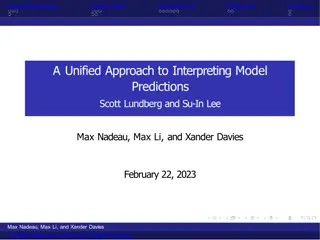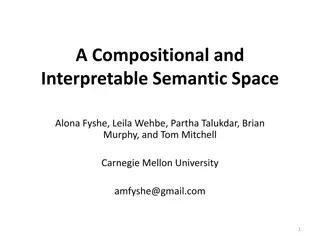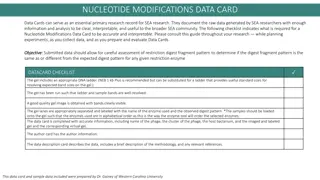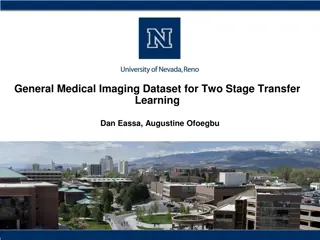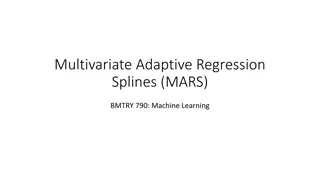Ethical Considerations in AI: Representation, Bias, and Fairness
Exploring the ethical dimensions of artificial intelligence (AI) reveals the unique position AI systems hold in behaving ethically. From causality to interpretability, bias, and privacy concerns, this discussion sheds light on the importance of ethical considerations in AI development and implementa
2 views • 25 slides
Enhancing Counterfactual Explanations for AI Interpretability
Explore how to improve interpretability of AI models through generating counterfactual explanations with minimal perturbations and realistic, actionable suggestions. Addressing limitations of current methods and the need for a more flexible generative framework to ensure explanations are clear, conc
5 views • 13 slides
Recent Advances in Large Language Models: A Comprehensive Overview
Large Language Models (LLMs) are sophisticated deep learning algorithms capable of understanding and generating human language. These models, trained on massive datasets, excel at various natural language processing tasks such as sentiment analysis, text classification, natural language inference, s
3 views • 83 slides
Counterfactual Explanations in AI Decision-Making
Delve into the concept of unconditional counterfactual explanations without revealing the black box of AI decision-making processes. Discover how these explanations aim to inform, empower, and provide recourse for individuals impacted by automated decisions, addressing key challenges in interpretabi
1 views • 25 slides
Logistic Regression Model Selection in Statistics
Statistics, as Florence Nightingale famously said, is the most important science in the world. In this chapter on logistic regression, we delve into model selection, interpretation of parameters, and methods such as forward selection, backward elimination, and stepwise selection. Guidelines for sele
7 views • 33 slides
Mechanistic Interpretability in Neural Networks
Delve into the realm of mechanistic interpretability in neural networks, exploring how models can learn human-comprehensible algorithms and the importance of deciphering internal features and circuits to predict and align model behavior. Discover the goal of reverse-engineering neural networks akin
8 views • 31 slides
A Unified Approach to Interpreting Model Predictions
Unified methodology for interpreting model predictions through additive explanations and Shapley values. It discusses the relationship between Additive Explanations and LIME, introduces Shapley values, approximations, experiments, and extensions in model interpretation. The approach unifies various
3 views • 21 slides
The Importance of Interpretability in Machine Learning for Medicine
Interpretability in machine learning models is crucial in medicine for clear decision-making and validation by medical professionals. This article discusses the definitions, global and local explanations, tradeoffs between interpretability and accuracy, and reasons why interpretable models are essen
0 views • 39 slides
Compositional and Interpretable Semantic Spaces in VSMs
This collection of images and descriptions dives into the realm of Vector Space Models (VSMs) and their composition, focusing on how to make a VSM, previous work in the field, matrix factorization, interpretability of latent dimensions, and utilizing SVD for interpretability. The research addresses
0 views • 40 slides
Analytic Rotation in Factor Analysis
Factor analysis involves rotation of the factor loading matrix to enhance interpretability. This process was originally done manually but is now performed analytically with computers. Factors can be orthogonal or oblique, impacting the interpretation of factor loadings. Understanding rotation simpli
2 views • 42 slides
Comprehensive Guide for Nucleotide Modifications Data Card in SEA Research
Nucleotide Modifications Data Cards are vital primary research records that document raw data generated by SEA researchers. The checklist ensures accuracy and interpretability when analyzing restriction digest fragment patterns. Follow the instructions for obtaining genomic sequences and comparing v
0 views • 8 slides
General Medical Imaging Dataset for Two-Stage Transfer Learning
This project aims to provide a comprehensive medical imaging dataset for two-stage transfer learning, facilitating the evaluation of architectures utilizing this approach. Transfer learning in medical imaging involves adapting pre-trained deep learning models for specific diagnostic tasks, enhancing
0 views • 16 slides
Machine Learning for Cybersecurity Challenges: Addressing Adversarial Attacks and Interpretable Models
In the realm of cybersecurity, the perpetual battle between security analysts and adversaries intensifies with the increasing complexity of cyber attacks. Machine learning (ML) is increasingly utilized to combat these challenges, but vulnerable to adversarial attacks. Investigating defenses against
1 views • 41 slides
Evaluating Interpretability in Machine Learning: Understanding Human-Simulatability Complexity
The paper discusses evaluating interpretability in Machine Learning by examining human-simulatability complexity and the relationship between decision set complexity and interpretability. It explores different factors affecting interpretability through user studies and highlights the significance of
0 views • 41 slides
Multivariate Adaptive Regression Splines (MARS) in Machine Learning
Multivariate Adaptive Regression Splines (MARS) offer a flexible approach in machine learning by combining features of linear regression, non-linear regression, and basis expansions. Unlike traditional models, MARS makes no assumptions about the underlying functional relationship, leading to improve
0 views • 42 slides
Explaining Models for Predicting At-Risk Students
Models for predicting at-risk students involve creating a predictive model to identify students at risk of failing a module early on. These models utilize machine learning algorithms, training data, and various factors to predict outcomes. Interpretable models focus on easily understandable criteria
0 views • 16 slides
Decision Tree Method for Energy Demand Modeling
This showcase presents a decision tree method developed by Zhun Yu, Fariborz Haghighat, Benjamin C.M. Fung, and Hiroshi Yoshino for building energy demand modeling at Worcester Polytechnic Institute. The method utilizes simple rules to partition variables and improve building design efficiency by pr
0 views • 15 slides
Leveraging Language Models for Commonsense Reasoning
Commonsense reasoning is crucial in AI models, yet modern ML methods struggle with it. This study explores how explanations can enhance reasoning in language models, focusing on the Common Sense Question Answering dataset. Key contributions include Common Sense Explanations (CoS-E) and Commonsense A
0 views • 4 slides
Leveraging Language Models for Commonsense Reasoning Exploration
This study delves into commonsense reasoning using language models, highlighting challenges faced by modern ML methods and the role of explanations in enhancing model reasoning abilities. The research introduces Common Sense Explanations and Commonsense Auto-Generated Explanations, showcasing improv
0 views • 36 slides
Unpacking Intelligibility
Intelligibility is a nuanced concept involving factors like expression recognition, meaning comprehension, and sociocultural context. Various scholars offer perspectives on intelligibility, comprehensibility, and interpretability, emphasizing the interplay between speakers and listeners in successfu
0 views • 15 slides
10th Meeting of the Washington Group Results - Upper Body and ICF Domain Objective
This content provides insights into the 10th Meeting of the Washington Group with a focus on Upper Body (UB) and the ICF Domain Objective. It covers the identification of individuals reporting upper body difficulties, testing aspects involved in cognitive testing, and the questions included to asses
0 views • 18 slides
Social-Emotional Learning: Understanding Effectiveness and Improving Assessment
Social-emotional skills have been shown to impact various outcomes, from academic success to overall well-being. Assessing and validating SEL approaches is crucial for enhancing educational programs. Developments in assessment methods and reporting strategies are essential to ensure the quality and
0 views • 6 slides
Revolutionizing Statistical Data Processes in Africa
The African Centre for Statistics and the Economic Commission for Africa are spearheading the modernization of statistical data processes to meet increased demands. This entails advancements in technology, quality assurance, metadata management, and embracing new data sources. Ensuring data quality,
0 views • 15 slides
Principles and Statistics of Exploratory Factor Analysis
Explore the principles behind factor analysis, understand how factors simplify data, and learn about interpretability in factor models to identify the best fitting solution. Discover the logic, effects, and importance of getting to a factor in statistical analysis.
0 views • 35 slides
Investigating Physics of Tokamak Operational Boundaries with Machine Learning
Explore the use of machine learning in predicting disruptions in Tokamaks and improving physics fidelity by combining ML tools with symbolic regression. Learn about the research on Hugill and beta limit plots lacking theoretical models for disruption prediction and the effectiveness of interpretabil
0 views • 17 slides
Understanding Tree-Based Genetic Programming for Improved Results
Explore tree-based genetic programming, a popular technique utilizing tree representations for generating solutions. Discover variants, mutations, and recombinations, enhancing interpretability and scalability in genetic programming.
0 views • 25 slides
Exploring Language Modeling for Generative Goal in Deep Learning
Discover the potential of language modeling in generating high-dimensional data and the concept of generative goals in deep learning. Explore workshops on interpretability experiments and understand the algorithmic process behind small language models creating probabilistic distributions.
0 views • 28 slides
Understanding Intelligibility, Comprehensibility, and Interpretability in Phonology and Phonetics
Explore the concepts of intelligibility, comprehensibility, and interpretability in phonology and phonetics, as defined by various researchers such as Smith, Nelson, Bamgbose, and James. Understand the distinctions and relationships between these terms in the context of language learning and communi
0 views • 9 slides
Enhancing Interpretability of Machine Learning Models for Better Decision-Making
Explore the importance of interpreting machine learning models for building trust, ensuring compliance, and preventing biased decisions. Research focuses on developing methods to make complex models transparent and understandable to improve their real-world applications across industries.
0 views • 17 slides
Understanding Variance in Genetics and Traits
Explore the concept of variance in genetics and traits, including its meaning, implications on trait distribution, interpretability across different distributions, and genetic variance models. Learn about the role of variance in explaining differences in traits between sexes and how transformations
1 views • 8 slides






